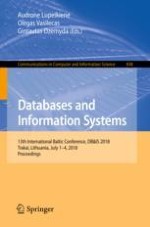2018 | Buch
Databases and Information Systems
13th International Baltic Conference, DB&IS 2018, Trakai, Lithuania, July 1-4, 2018, Proceedings
herausgegeben von: Audrone Lupeikiene, Olegas Vasilecas, Gintautas Dzemyda
Verlag: Springer International Publishing
Buchreihe : Communications in Computer and Information Science
